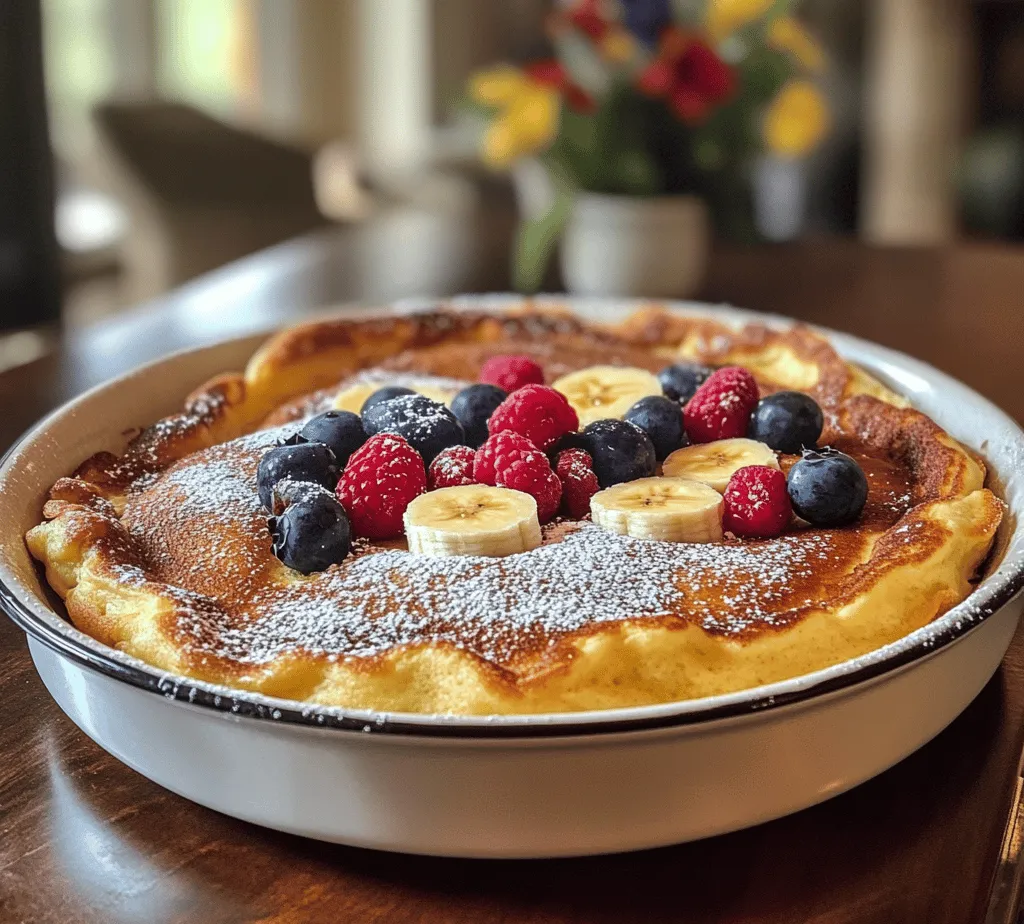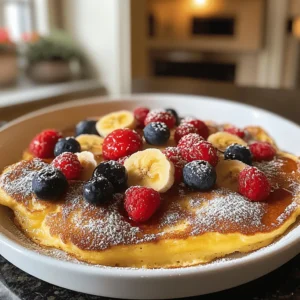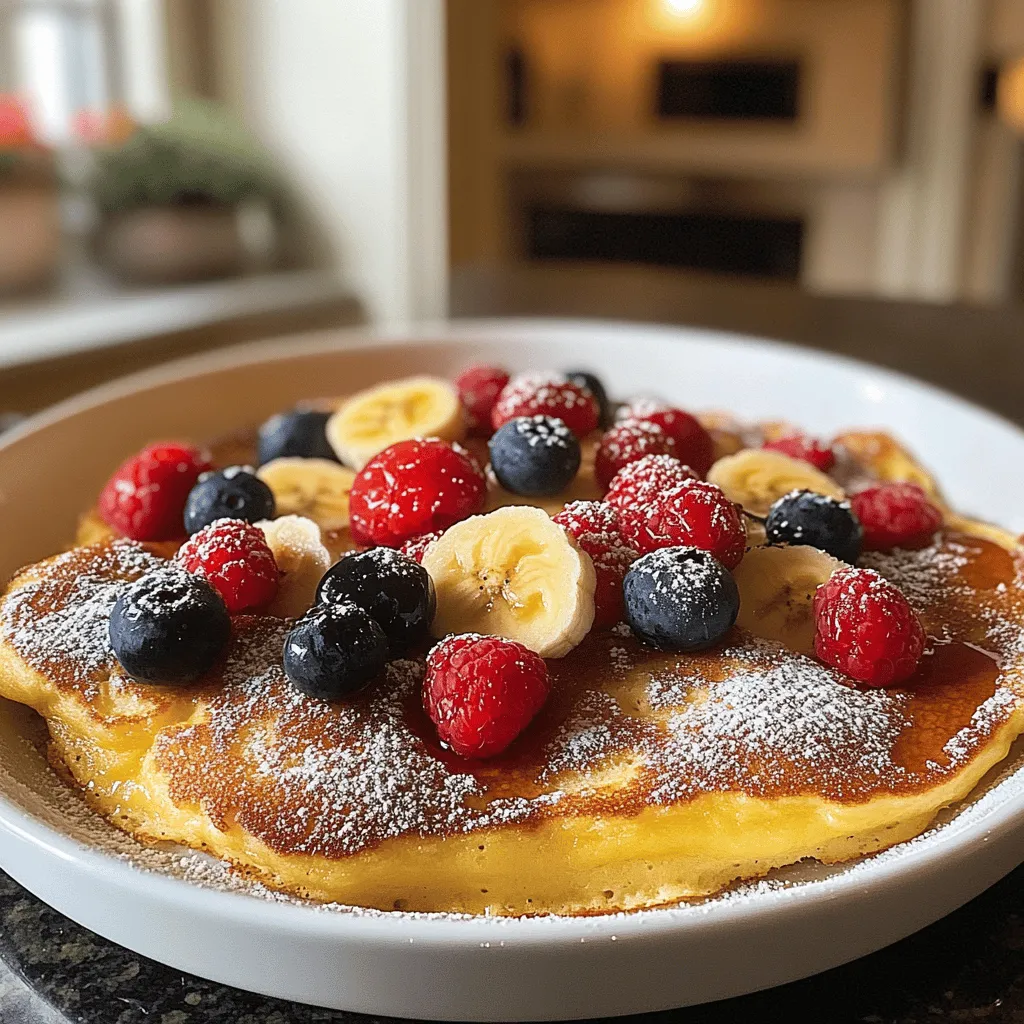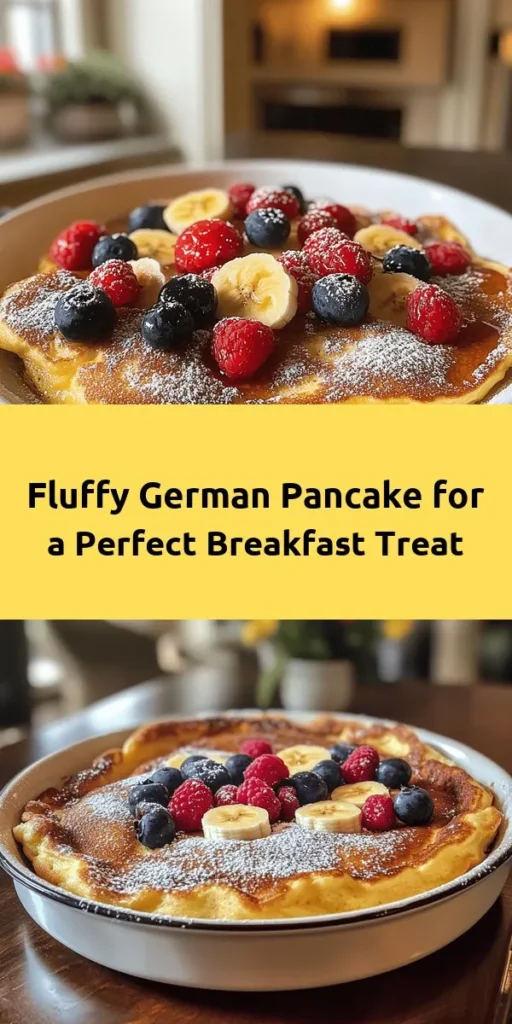Introduction to Fluffy Baked German Pancakes
There’s something truly magical about breakfast. It’s the meal that kickstarts your day, setting the tone for everything that follows. Among the many breakfast options available, the Fluffy Baked German Pancake stands out not only for its impressive rise and golden-brown edges but also for its versatility and ease of preparation. Originating from Germany, this delightful dish has transcended borders to become a beloved staple in various cultures around the world, making it a perfect choice for any meal, whether it’s breakfast, brunch, or even dessert.
Unlike traditional pancakes that are fried on a griddle, German pancakes are baked in the oven, allowing them to puff up dramatically. This unique cooking method results in a light and airy texture that is both visually stunning and satisfying to eat. As they bake, the edges become beautifully crisp while the center remains soft and custardy. The Fluffy Baked German Pancake can be served plain, dusted with powdered sugar, or topped with fresh fruits, syrups, or even whipped cream, making it a crowd-pleaser for family gatherings or brunch parties.
In this article, we will explore the essential ingredients needed to create the perfect Fluffy Baked German Pancake, delve into its rich history and cultural significance, and provide you with a step-by-step guide to making this delicious dish.
Understanding the Essence of German Pancakes
What Are German Pancakes?
At its core, a German pancake, also known as a Dutch baby, is a large, oven-baked pancake that is typically prepared in a cast-iron skillet or baking dish. Unlike traditional pancakes, which are made from a batter of flour, eggs, and milk and cooked individually in a frying pan, German pancakes are baked as a single, large pancake. The resulting dish is airy and custard-like in texture, thanks to the high egg content and the baking process that causes it to puff up dramatically.
The flavor of German pancakes is subtly sweet and buttery, making them an excellent canvas for various toppings. They can be served with a sprinkle of powdered sugar, a drizzle of maple syrup, or an assortment of fresh berries. The beauty of German pancakes lies in their adaptability; you can experiment with different flavors and toppings to suit your preference, making them a delightful addition to any breakfast spread.
The History Behind German Pancakes
The origins of German pancakes can be traced back to Germany, where they were traditionally known as “German pancakes” or “Dutch babies,” a name thought to have been coined by American expatriates. The dish has roots in the 19th century, and it’s likely that it evolved from various European pancake recipes. As German immigrants settled in the United States, they brought their culinary traditions with them, and the German pancake became a staple in many American households.
The cultural significance of German pancakes has grown over the years, as they became a popular breakfast item not only for their taste but also for their ease of preparation. Families have embraced the dish for its ability to feed a crowd with minimal effort, making it a favorite during holidays and special occasions. Today, German pancakes can be found on menus in restaurants and cafés across the country, showcasing their enduring appeal and versatility.
Essential Ingredients for Fluffy Baked German Pancakes
To create the perfect Fluffy Baked German Pancake, you will need a few simple yet essential ingredients. Each component plays a vital role in achieving the desired texture and flavor.
All-Purpose Flour
The foundation of any pancake recipe is flour, and for German pancakes, all-purpose flour is the most common choice. It provides the necessary structure and stability while allowing the pancake to rise beautifully as it bakes. The gluten content in all-purpose flour contributes to the pancake’s light and airy texture. If you’re looking for alternatives, you can experiment with cake flour for a softer texture or whole wheat flour for a nuttier flavor. However, keep in mind that using alternative flours may impact the pancake’s puffiness and overall texture.
Milk
Milk is another crucial ingredient in the recipe, as it adds moisture and richness to the batter. The fat content in milk also contributes to the overall flavor and texture of the pancake. Whole milk is preferred for its creaminess, but you can use lower-fat milk or dairy alternatives if desired. The key is to achieve a smooth batter that is not too thick or too runny; this will ensure that your pancake bakes evenly and puffs up as it cooks.
Eggs
Eggs are the star of the show when it comes to achieving the signature fluffiness of German pancakes. They provide structure and stability while also adding moisture to the batter. The high egg content in German pancakes is what allows them to rise and puff up dramatically in the oven. For the best results, use large eggs, and be sure to whisk them thoroughly until they are fully combined. This will help incorporate air into the batter, contributing to the pancake’s airy texture.
Granulated Sugar
While German pancakes are not overly sweet, a small amount of granulated sugar is essential for enhancing the overall flavor. Sugar not only adds sweetness but also helps to create a golden-brown crust as the pancake bakes. If you prefer a less sweet option, you can reduce the amount of sugar or use a natural sweetener like honey or maple syrup in the batter. However, remember that sugar also impacts the texture, so be cautious when making substitutions.
Vanilla Extract
Vanilla extract is a delightful addition that elevates the flavor profile of your German pancakes. It adds a warm, aromatic quality that complements the other ingredients beautifully. Using pure vanilla extract is recommended for the best flavor, but imitation vanilla can also work in a pinch. A teaspoon of vanilla extract is all you need to enhance the overall taste and make your pancakes even more enjoyable.
Salt
Salt is a vital ingredient in any baked good, and German pancakes are no exception. A pinch of salt helps to balance the sweetness and enhances the overall flavor of the dish. It also plays a role in strengthening the protein structure in the batter, contributing to the pancake’s texture. Don’t skip this ingredient; even a small amount can make a significant difference in the final result.
Unsalted Butter
Finally, unsalted butter is used in the recipe to add richness and flavor. It also helps to create a crispy edge on the pancake as it bakes. Using unsalted butter allows you to control the saltiness of the dish, ensuring that the flavors remain balanced. Be sure to melt the butter before adding it to the batter, as this will help it incorporate smoothly.
Step-by-Step Instructions for Making Fluffy Baked German Pancakes
Now that we’ve discussed the ingredients, let’s move on to the exciting part: making your Fluffy Baked German Pancake! Follow these step-by-step instructions to ensure your pancake comes out perfectly every time.
Preparing Your Cooking Space
Before you start, it’s essential to gather all your ingredients and tools. This not only makes the cooking process smoother but also ensures you don’t forget any crucial elements. Here’s what you’ll need:
– A large mixing bowl
– A whisk or electric mixer
– A measuring cup and spoons
– A cast-iron skillet or a baking dish (around 10-12 inches)
– An oven mitt (for handling the hot skillet)
Once you have everything ready, preheat your oven to 425°F (220°C). Preheating is crucial for achieving the optimal puffiness of your German pancake, so don’t skip this step!
Preheating the Oven
As your oven heats, place your skillet or baking dish inside. This will allow the pan to become hot and ready for the batter, ensuring that the pancake starts to cook immediately upon contact. This initial heat is what helps create the signature rise and golden-brown edges of the Fluffy Baked German Pancake.
Mixing the Ingredients
Once your oven is preheated, it’s time to mix your ingredients. In a large mixing bowl, combine the all-purpose flour, granulated sugar, and salt. Whisk these dry ingredients together until they are well incorporated.
In a separate bowl, add the eggs and whisk them until frothy. Then, pour in the milk and melted unsalted butter, along with the vanilla extract. Whisk these wet ingredients together until they are smooth and well combined.
Now, gradually add the dry ingredients to the wet mixture. It’s best to do this in small batches to prevent clumps from forming. Continue whisking until you achieve a smooth batter with no lumps. The batter should be relatively thin, similar in consistency to a crepe batter.
Once your batter is ready, carefully remove the hot skillet from the oven. Pour the batter into the skillet, making sure it spreads evenly across the bottom. The sizzling sound you hear as the batter touches the hot pan is a good sign; it indicates you’re on your way to creating that perfect puffiness.
Now, it’s time to return the skillet to the oven and let the magic happen!
As this article continues, we’ll explore additional tips for achieving the best results with your Fluffy Baked German Pancake, along with serving suggestions to make this dish even more delightful.

Melting the Butter
To create the perfect Fluffy Baked German Pancake, the first step is melting the butter. Begin by preheating your oven to 425°F (220°C). This high temperature is crucial as it helps the pancake achieve that beautiful puffiness that makes it so special. While the oven is heating, take a heavy, oven-safe skillet—preferably cast iron or a thick stainless steel pan—and place it on the stove over medium heat.
Add 4 tablespoons of unsalted butter to the skillet. As the butter begins to melt, gently swirl the pan to ensure that the butter coats the bottom and the sides evenly. This not only adds flavor but also prevents the pancake from sticking. It’s important to keep an eye on the butter; you want it to melt completely without browning. Once fully melted and bubbly, remove the skillet from the heat. This step is vital because pouring the batter into a hot, buttered skillet helps the pancake rise beautifully in the oven.
Pouring the Batter
Timing is everything when it comes to pouring the batter into the skillet. After the butter has melted, allow it to cool slightly for about 1-2 minutes. Meanwhile, ensure your batter is ready. The mixture should be smooth and well-combined but avoid overmixing, which can lead to a dense pancake.
Once the butter has finished bubbling, carefully pour the batter into the center of the skillet. The hot butter will sizzle as the batter hits it, and this is an excellent sign that your pancake will have a delightful texture. Ensure that you pour the batter quickly and evenly to create a uniform pancake. Immediately return the skillet to the oven.
Baking to Perfection
Now, the magic happens. Bake the pancake for about 20-25 minutes. You’ll know the pancake is perfectly baked when it has puffed up significantly and the edges have turned a golden brown. The center should be just set but still soft. Look for a slight jiggle when you gently shake the skillet; this indicates a fluffy texture. The top should also be slightly crisp, providing a delightful contrast to the soft interior.
Avoid opening the oven door during the first 15 minutes of baking, as this can cause the pancake to deflate. Instead, use the oven light to check on its progress. Once the time is up, carefully remove the skillet from the oven using oven mitts, as it will be extremely hot.
Cooling and Serving
Let the pancake cool in the skillet for about 5 minutes before serving. This brief cooling period allows the pancake to settle slightly, making it easier to slice and serve. To present, simply cut the pancake into wedges—think of pizza slices—and serve directly from the skillet or transfer to a large plate.
For an inviting presentation, sprinkle a dusting of powdered sugar over the top before serving. This not only adds a touch of elegance but also enhances the visual appeal. Consider using a thin sieve for an even distribution of sugar.
Serving Suggestions for Fluffy Baked German Pancakes
Toppings: A World of Flavor
The beauty of Fluffy Baked German Pancakes lies in their versatility. You can tailor the toppings to your taste or the season. Here are some delightful suggestions to elevate your pancake experience:
– Powdered Sugar: A classic choice that adds sweetness without overpowering the pancake’s delicate flavor.
– Fresh Fruits: Seasonal berries like strawberries, blueberries, or raspberries bring a burst of freshness. Sliced bananas are another great option, offering a creamy texture that pairs well with the pancake’s fluffiness.
– Maple Syrup: Drizzling warm maple syrup over the pancake adds a sweet, rich flavor that enhances its overall taste. For an added kick, try flavored syrups like caramel or blueberry.
Pairing with Beverages
Complement your Fluffy Baked German Pancakes with the right beverages. A freshly brewed cup of coffee balances the sweetness of the pancake while adding a robust flavor. Alternatively, a light herbal tea can provide a refreshing contrast, especially if you prefer a non-caffeinated option. Fresh juices, particularly orange or apple juice, can add a bright, fruity note that enhances the overall breakfast experience.
Nutritional Information of Fluffy Baked German Pancakes
Overview of Nutritional Benefits
Understanding the nutritional content is essential for those who are health-conscious. A serving of Fluffy Baked German Pancake—typically one slice—contains approximately:
– Calories: 200-250
– Protein: 6-8 grams
– Fats: 9-12 grams
– Carbohydrates: 30-35 grams
This pancake offers a balanced combination of macronutrients, making it a satisfying meal to start your day.
Modifications for Healthier Options
If you want to make the pancake healthier or cater to dietary preferences, consider these modifications:
– Gluten-Free: Substitute all-purpose flour with a gluten-free blend. Ensure that the blend includes xanthan gum for better structure.
– Dairy-Free: Use plant-based milk (like almond or oat milk) and replace butter with coconut oil or a dairy-free margarine.
– Reduced Sugar: You can decrease the sugar in the batter to suit your taste without compromising the pancake’s fluffiness.
Common Mistakes to Avoid When Making German Pancakes
Overmixing the Batter
One of the most common mistakes when making German pancakes is overmixing the batter. While it’s tempting to ensure everything is perfectly combined, overmixing can lead to a tough texture. Mix just until the ingredients are incorporated—small lumps are perfectly fine.
Incorrect Oven Temperature
Baking at the wrong temperature can also ruin a good German pancake. Too low a temperature will prevent it from rising properly, resulting in a flat pancake. Conversely, an excessively high temperature can cause the edges to burn before the center is fully cooked. Always use an oven thermometer to ensure your oven is accurate.
Not Using the Right Pan
Using the wrong type of pan can significantly affect the outcome. A lightweight pan may not retain heat well, leading to uneven cooking. Always use a heavy, oven-safe skillet, preferably cast iron, for the best results.
Conclusion: Embracing the Joy of Fluffy Baked German Pancakes
Fluffy Baked German Pancakes are more than just a breakfast dish; they are a delightful experience that brings a taste of Germany to your table. With their light and airy texture, these pancakes can elevate any breakfast or brunch gathering, impressing family and friends alike.
By following this detailed guide, from melting the butter to selecting the perfect toppings, you can create a stunning pancake that both looks and tastes exceptional. Whether enjoyed on a leisurely weekend morning or served at a festive brunch, these pancakes are sure to become a beloved staple in your kitchen. Embrace the joy of cooking and indulge in this delightful dish, which combines simplicity with elegance, ensuring that every bite is a celebration of flavor and comfort.



